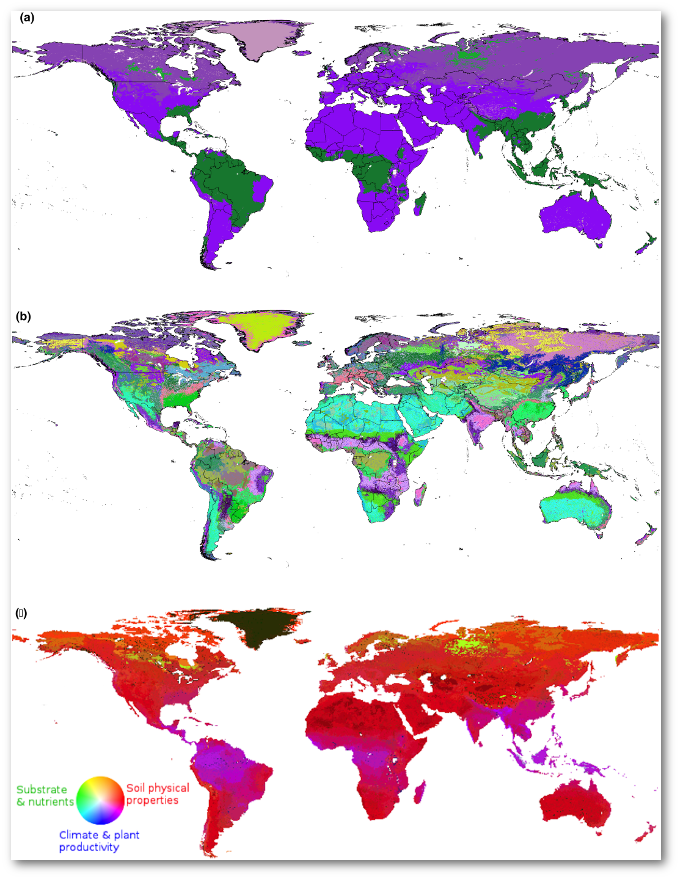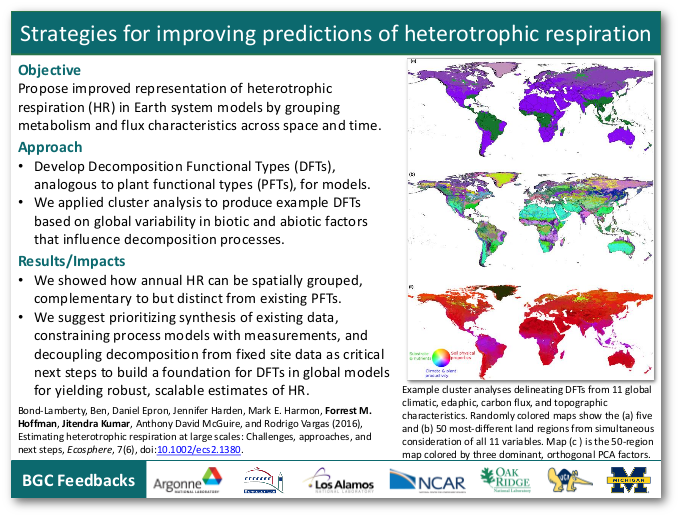Research Highlights
Strategies for improving predictions of heterotrophic respiration
June 27, 2016
The Science
We proposed improving representation of heterotrophic respiration (HR) in Earth system models by grouping metabolism and flux characteristics across space and time.
The Impact
We argued for development of Decomposition Functional Types (DFTs), analogous to plant functional types (PFTs), for use in global models. We applied cluster analysis to produce example DFTs based on the global variability in 11 biotic and abiotic factors that influence decomposition processes.
Summary
Heterotrophic respiration (HR), the aerobic and anaerobic processes mineralizing organic matter, is a key carbon flux but one impossible to measure at scales significantly larger than small experimental plots. This impedes our ability to understand carbon and nutrient cycles, benchmark models, or reliably upscale point measurements. Given that a new generation of highly mechanistic, genomic-specific global models is not imminent, we suggest that a useful step to improve this situation is the development of Decomposition Functional Types (DFTs). Analogous to plant functional types (PFTs), DFTs would abstract and capture important differences in HR metabolism and flux dynamics, allowing modelers and experimentalists to efficiently group and vary these characteristics across space and time. We applied cluster analysis to show how annual HR can be broken into distinct groups associated with global variability in biotic and abiotic factors, and we demonstrated that these groups are distinct from, but complementary to, PFTs. In this position paper, we suggested priorities for next steps to build a foundation for DFTs in global models to provide the ecological and climate change communities with robust, scalable estimates of HR.
Objective
Propose improved representation of heterotrophic respiration (HR) in Earth system models by grouping metabolism and flux characteristics across space and time.
Approach
- Develop Decomposition Functional Types (DFTs), analogous to plant functional types (PFTs), for models.
- We applied cluster analysis to produce example DFTs based on global variability in biotic and abiotic factors that influence decomposition processes.
 |
Example cluster analyses delineating DFTs from 11 global climatic, edaphic, carbon flux, and topographic characteristics. Randomly colored maps show the (a) five and (b) 50 most-different land regions from simultaneous consideration of all 11 variables. Map (c ) is the 50-region map colored by three dominant, orthogonal PCA factors. |
Results/Impacts
- We showed how annual HR can be spatially grouped, complementary to but distinct from existing PFTs.
- We suggested prioritizing synthesis of existing data, constraining process models with measurements, and decoupling decomposition from fixed site data as critical next steps to build a foundation for DFTs in global models for yielding robust, scalable estimates of HR.
Bond-Lamberty, Ben, Daniel Epron, Jennifer Harden, Mark E. Harmon, Forrest M. Hoffman, Jitendra Kumar, Anthony David McGuire, and Rodrigo Vargas. June 27, 2016. “Estimating Heterotrophic Respiration at Large Scales: Challenges, Approaches, and Next Steps.” Ecosphere, 7(6). doi:10.1002/ecs2.1380.
